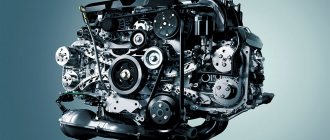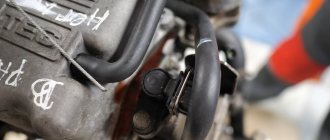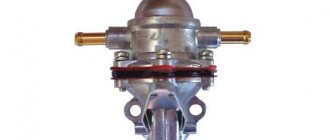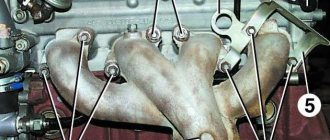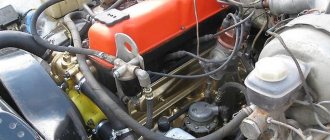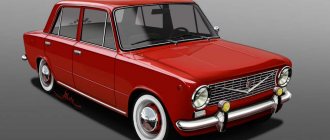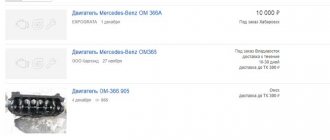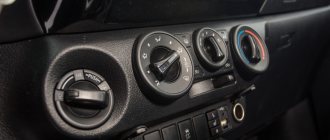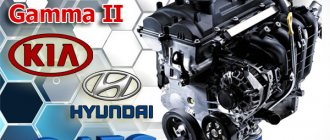You can contact the site administrator by email: [email protected]
All texts were written by me, are authored by Google, included in the original Yandex texts and notarized. For any borrowing, we immediately write an official letter on company letterhead in support of search networks, your hosting and domain registrar.
Next we go to court. Don’t try your luck, we have more than thirty successful Internet projects and have already won a dozen lawsuits.
Source
Technical specifications F16D3 1.6 l/109 l. With.
The internal combustion engines of the Daewoo and Chevrolet manufacturers available in 2002 did not meet Euro-5 standards. For restyling, a new power drive was required; it was necessary to increase power and throttle response at low speeds. To achieve this, management expectedly used standard methods:
- the volumes of combustion chambers have been increased;
- the cross section of the exhaust tract is narrowed;
- The manufacturer used adjustment of motor parameters due to ECU firmware versions.
the engine has an EGR valve for exhaust cleaning;
The unchanged engine design - 4 cylinders in a row, 16 valves controlled by two camshafts - was improved due to hydraulic compensators. Thermal clearances of the valves no longer need to be adjusted, but the manual strongly recommends the use of high-quality oil to avoid clogging of the hydraulic system channels.
The table shows the technical characteristics of the F16D3 power drive:
| Manufacturer | GM DAT |
| Engine brand | F16D3 |
| Years of production | 2004 – … |
| Volume | 1598 cm 3 (1.6 l) |
| Power | 80.2 kW (109 hp) |
| Torque moment | 150 Nm (at 4200 rpm) |
| Weight | 112 kg |
| Compression ratio | 9,5 |
| Nutrition | injector |
| Motor type | in-line petrol |
| Ignition | common coil |
| Number of cylinders | 4 |
| Location of the first cylinder | TVE |
| Number of valves on each cylinder | 4 |
| Cylinder head material | aluminum alloy |
| Intake manifold | variable geometry |
| An exhaust manifold | scheme 4/1, cast iron |
| Camshaft | cast iron |
| Cylinder block material | cast iron |
| Cylinder diameter | 79 mm |
| Pistons | aluminum |
| Crankshaft | cast iron, cast counterweights, 5 supports, 4 crank journals, steel liners |
| Piston stroke | 81.5 mm |
| Fuel | AI-95 |
| Environmental standards | Euro 5 |
| Fuel consumption | highway – 5.6 l/100 km combined cycle 7.3 l/100 km city – 9.2 l/100 km |
| Oil consumption | maximum 0.6 l/1000 km |
| What kind of oil to pour into the engine by viscosity | 5W30, 5W40, 10W30, 0W40 |
| Which engine oil is best by manufacturer | GM Dexos-2 or any manufacturer of class LLS-A-025 |
| Oil for F16D3 by composition | synthetics, semi-synthetics |
| Engine oil volume | 3.75 l |
| Operating temperature | 95° |
| ICE resource | declared 250,000 km actual 350,000 km |
| Adjustment of valves | hydraulic compensators |
| Cooling system | forced, antifreeze |
| Coolant volume | 6.3 l |
| water pump | Aisin WO-006 with steel impeller |
| Spark plugs for F16D3 | ZFR5F11 or BKR6E11 from NGK or domestic AU17DVRM |
| Spark plug gap | 1.1 mm |
| Timing belt | GM/Daewoo 96417177 |
| Cylinder operating order | 1-3-4-2 |
| Air filter | Sakura A65430, PMC PAC043, Filtron AP051/8, Knecht LX2882, Mann C26106 |
| Oil filter | BIG GB108, Filtron OP570, Knecht OC90, Mann W712/75 |
| Flywheel | 7 – 9 kg depending on the type of car |
| Flywheel mounting bolts | M12x1.25 mm, length 26 mm |
| Valve stem seals | manufacturer Goetze |
| Compression | from 12 bar, difference in adjacent cylinders maximum 1 bar |
| XX speed | 800 – 850 min -1 |
| Tightening force of threaded connections | spark plug – 25 Nm flywheel – Nm + 30° + 15° clutch bolt – 35 Nm bearing cap – 50 Nm + 45° + 15° (main) and 25 Nm + 30° + 15° (rod) cylinder head – four stages 25 Nm + 70° + 70° + 50° |
To ensure such a resource, it is recommended to reduce the maintenance periods given in the user manual. For example, change the oil not after 15,000 km, but after 7.5 thousand or at least 10,000 miles.
Maintenance
Operation of Chevrolet Aveo (F16D3), Chevrolet Cruze (F16D4 and F18D4) engines and other cars is carried out in accordance with the manufacturer's requirements for regular maintenance. Chevrolet Lacetti oil changes are carried out every 15 thousand km.
They include:
For engines installed on Chevrolet Cruze (F18D4), replacement:
- oil and fuel filters are produced no later than after 15,000 km. Used Chevrolet Cruze engine oil also requires replacement after 15 thousand km;
- spark plugs are performed after 60,000 km of travel;
- The drive belt and timing mechanism rollers are carried out no later than after 150 thousand kilometers. At the same time, after 100 thousand km, its condition must be checked and, at the slightest suspicion, changed. If the belt breaks during a trip, then expensive repairs cannot be avoided (the valve will bend);
- It is advisable to carry out the air filter after every 50,000 km traveled;
- The manufacturer recommends replacing coolant once every 5 years or no later than 240 thousand km of the distance traveled.
In engines of Chevrolet Aveo, Daewoo Lanos and others, replacement:
- engine oil is carried out every 15 thousand km of the distance traveled. It is also necessary to replace the oil, air and fuel filters;
- spark plugs must be checked after 45 thousand km;
- the belt and rollers of the gas distribution mechanism drive are performed every 60 thousand km to avoid valve failure;
- It is recommended to change the coolant once every two years.
In the Chevrolet Cruze engine (F18D4, etc.) during routine maintenance the following is changed:
- engine oil, gasoline and fuel filters - every 15 thousand km;
- spark plugs - after 60,000 km of travel;
- timing belt and rollers - after 100...150,000 km. If the belt breaks during movement, the valve bends;
- coolant - after 240,000 km or 5 years of operation (depending on which event comes first);
- air filter - no later than after 50,000 km.
Consumables for Chevrolet Lanos engines and engines of other cars manufactured by General Motors
The American concern General Motors, along with engines and cars, produces auto chemical products. The concern manufactures these products in strict accordance with the requirements for Chevrolet Cruze engines and their analogues.
That is why the technical documentation provides recommendations for using the original:
- GM Dexos 2 Long Life 5W-30 engine oil;
- GM Long Life Dex Cool antifreeze.
GM Dexos 2 Long Life 5W-30 engine oil is an original product, the chemical composition of which includes special additives that extend its service life and significantly increase the time interval between replacements.
The original antifreeze super concentrate GM Long Life Dex Cool has a unique chemical composition and has excellent anti-corrosion properties. The anti-corrosion substance, together with antifreeze, helps raise the boiling point and, in addition, prevents the coolant from freezing when exposed to low temperatures.
The antifreeze also contains emission inhibitors, which provide an extended service life (up to 250 thousand km or 5 years of operation).
Antifreeze of this class is intended for use in Chevrolet Aveo, Daewoo Nexia, etc. engines.
Adjusting the timing valve clearances
The engine of the Chevrolet Lacetti and other cars (F16D3) is equipped with hydraulic valve compensators, and therefore regular adjustment of the valve clearances is not required. The Chevrolet Cruze engine uses calibrated cups instead of hydraulic compensators, with the help of which valve clearances are adjusted. This procedure is carried out during maintenance at a service station after every 100,000 km.
Design Features
The transversely mounted F16D3 naturally-aspirated petrol engine for front-wheel drive cars has some design nuances:
- attachments - power steering pump, air conditioning compressor, oil pump and pump on the right, belt drive, recirculation valve and ignition coil on the left, exhaust manifold in front, fuel rail, generator, starter and intake manifold in the rear;
- the engine cylinders are bored inside a cast iron block, and the cooling jacket is obtained during its casting;
- forced cooling system;
- combustion chambers are domed, spark plugs are located in the center;
- The timing belt drive is a belt drive; if it breaks, the piston bends the valve.
Factory boost is made by boring the cylinders and changing the piston stroke. However, the center-to-center distance leaves the potential for a further increase in the diameter of the cylinders, so modernization of the CPG is possible, and overhauls do not cause difficulties, even when done with your own hands in the garage.
Engine tuning options
Experts say that the F16D3 engine has a potential of 70 hp. With. without reducing the service life, therefore, atmospheric tuning without turbocharging is preferable:
- installation of camshafts with a lift of 9.75 mm and phases of 275 degrees instead of the standard equipment;
- using a “spider” instead of the original exhaust manifold with dismantling the catalytic converter and installing a “fake” on the second CO sensor;
- firmware firmware in the on-board computer to adjust new settings.
Tuning F16D3
Such tuning will provide 125 - 130 hp. pp., the accelerator response will improve, even at low speeds. Professional studios often use classic VAZ tuning:
- cylinder bore by 1.5 mm;
- selection of the appropriate ShPG set;
- installation of a zero resistance filter;
- grinding the intake manifold channels.
Thus, the F16D3 motor has an overall user rating of +4 and has a high service life. It is not burdensome to maintain; you can carry out major repairs on your own. The engine was created for cars of the GM corporation, it was installed even on ZAZ, without causing problems to the owner.
Advantages and disadvantages
In addition to the characteristic disadvantages of all engines of this family - reduced traction, overheating, oil leakage and unstable idle speed, the F16D3 engine has the following disadvantages:
- deliberate reduction in power by the manufacturer to ensure Euro-5 standards;
- increased fuel consumption in the urban cycle.
On the other hand, the simple design of the power unit facilitates major overhauls. The manual provides a description of all maintenance and repair operations for performing them on your own. The advantages of the motor are:
- small dimensions and well-located attachments that do not interfere with engine repair and maintenance;
- high service life, due to which the power drive conventionally belongs to the “millionaires”;
- a very reliable cylinder head with a common cover and a high-life gasket.
The plant's designers included a minimum number of complex components. There is practically nothing to break here; Daewoo, ZAZ and Chevrolet cars with these engines are still in use in the Russian Federation.
Weaknesses and malfunctions
Land rover range rover velar (Land Rover Range Rover Velar)
Let's take a closer look at them.
- Oil leaks are not going anywhere. It escapes through the valve cover if the gasket is not replaced in a timely manner.
- The comb of the ignition module is unfinished.
- The electrical control of the thermostat quickly breaks down.
- The cooling system does not always cope with intense thermal conditions.
- DVVT pulley failures are common.
- Due to the deliberately narrowed cross-section of the exhaust manifold for Euro 5, exhaust volumes increase. This is an extra load on the muffler, increasing the risk of overheating and reduced power.
If the timing belt is not replaced in time, the valves will bend due to a break. In addition, the F16D4 engine may become sick with loss of power over time. This occurs due to the failure of the DVVT system. It is urgent to replace the shafts and adjust the valve control phases.
If misfire or lack of ignition is observed, this is most likely due to a breakdown of the ignition module. In this case, repair will not help, only replacement will save you.
Another common malfunction of this motor is overheating. It occurs due to a malfunction of the thermostat. Replacing the element will help correct the situation.
If fuel consumption suddenly increases, the rings may be stuck or the DVVT system may be broken. Needs repair or replacement of parts.
List of car models in which it was installed
Initially, the F16D3 engine was mounted on several cars from the Daewoo manufacturer:
- Lanos – convertible, sedan, hatchback;
- Nexia/Cielo/Lemans/Racer/Pointer – sedan, hatchback;
- Lacetti – station wagon, hatchback, sedan.
In the Korean market, Daewoo Nexia was called Cielo. The engine performance characteristics were also suitable for another manufacturer, Chevrolet:
- Lanos – convertible, sedan, hatchback;
- Lacetti – station wagon, hatchback, sedan;
- Cruze – station wagon, hatchback, sedan;
- Aveo/Sonic – sedan, hatchback.
The Zaporozhye Automobile Plant used components from Daewoo and Chevrolet for the ZAZ Chance, so the engine was originally installed in these sedans/hatchbacks. Later ZAZ switched to its own engines from Slavuta and Tavria. The Taganrog Automobile Plant TagAZ assembled Lanos with this power unit in the period 1998 - 2000.
In Rostov-on-Don, a car with this engine was called Doninvest Assol, rolled off the assembly line within a year, but production was curtailed due to late deliveries of components by the Korean parent company.
In Canada, the Chevrolet Aveo was called either the Pontiac Wave or Suzuki Swift, and in New Zealand, the Holden Barina.
About engines for Chevrolet Lacetti
The Chevrolet Lacetti golf car replaced the Nubira in the model range and was first known as the Daewoo Lacetti. Today it has been replaced on the world market by the Chevrolet Cruze, but, nevertheless, the car continues to be assembled in Uzbekistan, already called Daewoo Gentra. The variety of engines under the hood of the Chevrolet Lacetti depended on the sales market.
Engine Chevrolet AveoLacetti 1.4 l F14D3
The F14D3 power unit was developed in the early 2000s for small cars. In fact, the motor repeated the design of Opel's X14XE produced in 1998 and many of the parts in them are interchangeable, and the parameters of the crankshaft are identical.
The engine was equipped with hydraulic compensators, which eliminate the need to adjust valve clearances.
Due to the EGR valve, the content of harmful emissions is reduced, since the substances are re-burned in the cylinders. The timing belt drive will have to be changed every 60 thousand kilometers, since if it breaks, the valves will bend.
The main disadvantage of the F14D3 engine is valve hanging due to carbon deposits that form in the small gap between the valve and the bushing. As a result, the engine begins to stall, function unstably, stall, lose power, and so on. The problem can be solved by using high-quality fuel and warming up the engine to 80 degrees before starting.
Engine trouble also occurs due to the design features of the injectors, which often become dirty.
Premature failure of the thermostat was noticed, which negatively affects the engine temperature.
A clogged fuel pump grid affects the traction and movement of the engine.
In F14D3, valve cover gaskets quickly deteriorate and leaks occur.
Faulty hydraulic compensators cause knocking noise in the engine.
A questionable ERG valve with low-quality fuel is prone to the formation of carbon deposits on it, which affects the operation of the engine. 4-
Engine Cruze/Aveo/Lacetti 1.6 l F16D3
The F16D3 power unit received the same block as the F14D3 or F18D3 and is practically a copy of the Opel Z16XE engine produced in 2001 with the same crankshaft parameters and interchangeable spare parts.
Exhaust toxicity is reduced by the ERG valve, but due to low-quality fuel, carbon deposits often form in this system and the engine stops functioning. To solve the problem, experts recommend turning off the entire system. This deficiency was resolved in 2008.
In general, the shortcomings of the Cruze/Aveo/Lacetti 1.6 liter F16D3 are the same as those of its 1.4 liter counterpart.
In 2008, the F16D3 engine was replaced by the F16D4, which received a variable gas distribution system and increased performance. 4-
| Engines | AveoLacetti 1.4 l F14D3 | Cruze/Aveo/Lacetti 1.6 l F16D3 |
| Production | GM DAT | GM DAT |
| Engine make | F14D3 | F16D3 |
| Years of manufacture | 2004 - our time | 2004 - our time |
| Cylinder block material | cast iron | cast iron |
| Supply system | injector | injector |
| Type | Row | Row |
| Number of cylinders | 4 | 4 |
| Valves per cylinder | 4 | 4 |
| Piston stroke, mm | 73,4 | 81,5 |
| Cylinder diameter, mm | 77,9 | 79 |
| Compression ratio | 9,5 | 9,5 |
| Engine capacity, cc | 1399 | 1598 |
| Engine power, hp/rpm | 94/6200 | 109/5800 |
| Torque, Nm/rpm | 130/3400 | 150/4000 |
| Fuel | 95 | 95 |
| Environmental standards | Euro 4 | Euro 5 |
| Engine weight, kg | 112 | 112 |
| Fuel consumption, l/100 km (for Celica GT) - city - highway - mixed. | 8,6 6,1 7 | — — 7,3 |
| Oil consumption, g/1000 km | Up to 600 | Up to 600 |
| Engine oil | 10W-30 5W-30 | 10W-30 5W-30 |
| How much oil is in the engine | 3.75 | 3.75 |
| Oil change carried out, km | 15000 | 15000 |
| Engine operating temperature, degrees. | ||
| Engine life, thousand km - according to the plant - in practice | n. d. 200-250 | n.d. 200-250 |
| Tuning - potential - without loss of resource | n. d. ~120 | n. d. ~125 |
| The engine was installed | Chevrolet Aveo Chevrolet Lacetti | Chevrolet Aveo Chevrolet Lacetti Chevrolet Cruze Daewoo Lanos Chevrolet Lanos Daewoo Nexia Daewoo Lacetti ZAZ Chance |
The essence of the product. Test drive of the new Renault Kaptur with a turbocharged engine
See all photo news >>
Maintenance schedule F16D3 1.6 l/109 l. With.
In order for the F16D3 engine to really be able to operate for the stated 250,000 km without major overhauls, you must adhere to the following terms for replacing consumables and carry out maintenance operations:
- fuel filter - becomes clogged at approximately 15,000 km;
- air filter cartridge - becomes unusable after a year of use;
- spark plugs - it is recommended to check the resistance annually, change after a maximum of 20,000 mileage;
- Battery – service life is specified by the manufacturer, varies significantly depending on the design of the battery;
- motor oil and corresponding filter - in Russian Federation conditions it is recommended to update every 7.5 - 10 thousand mileage;
- timing belt - when using Gates products, the service life is from 150,000 km; in practice, belts with a service life of 60 - 90 thousand km are used;
- attachment belts – confidently cover 30,000 km;
- antifreeze - loses its properties after 20,000 km or within 2 years;
- crankcase ventilation - needs to be purged every 2 years.
The exhaust manifold begins to burn out after 30,000 km, however, if the internal combustion engine device in the exhaust tract is modernized by the owner, this unit will last longer, and environmental standards will drop to Euro-2/3.
Basic malfunctions and methods for their elimination
The F16D3 engine, which has a lifespan of up to 250 thousand kilometers, has its drawbacks, and if improperly maintained or if operating rules are not followed, it can malfunction. Below are the main engine problems, their causes and solutions:
- The engine is overheating. This problem can occur due to a thermostat failure, a pump failure, or a clogged radiator. It is recommended to clean the radiator and replace faulty elements. For the thermostat, the control period is 50 thousand km. mileage
- The motor doesn't pull. The fuel grid on the pump is clogged or there is a malfunction in the high-voltage wires. It is necessary to replace the wiring, clean the mesh, and then use high-quality fuel.
- At idle speed the power unit is unstable. The fuel injectors of the original configuration are clogged. In this case, the injectors should be professionally cleaned at a service station.
- There is an oil leak through the gasket. It is possible that the replacement period for the element has passed, which needs to be updated every 590 thousand km.
- The valves of the F16D3 engine freeze (the engine begins to stall and stall). Most likely, carbon deposits have formed between the guide sleeve and the valve, making it difficult to move the element. It is necessary to remove carbon deposits, then use high-quality gasoline and warm up the engine to at least 80 degrees Celsius.
- Extraneous noises and knocking are heard in the engine. Mostly, the problem occurs with hydraulic valve compensators. The malfunction can be eliminated only after diagnostics in a car service center.
- Unstable, intermittent operation of the power plant is observed. The reason is the appearance of carbon deposits on the EGR valve. Plugging the exhaust gas recirculation system will help temporarily solve the problem.
